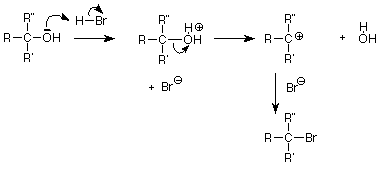Alcohols can undergo nucleophilic substitution with $\ce{PCl5, POCl3, HCl}$. Halogenoalkanes can undergo nucleophilic substitution with $\ce{NH3}$. The $\ce{C-O}$ (in alcohol) and $\ce{C-Cl}$ (in chloroalkanes) bond energies are comparable. Why don't alcohols undergo nucleophilic substitution with $\ce{NH3}$?
4 Answers
To build on ssavec's answer: Nucleophilic substitution reactions require two species: a nucleophile (a Lewis Base) and a substrate with a leaving group. Nucleophiles are often generically represented as $\ce{Nu}$ and leavings groups as $\ce{LG}$.
All leaving groups are not created equal. The leaving group ability of a leaving group is defined as the relative rates of a particular analogous series of substitutions. For example, the relative leaving group ability might be based on the following reaction, with rates determined for various leaving groups:
$$\ce{EtOH + PhCH(LG)CH3 -> PhCH(OEt)CH3 + H-LG}$$
This is an $\mathrm{S_N1}$ substitution, so the first (and rate determining) step of the mechanism is loss of the leaving group (and is independent of the nucleophile):
$$\ce{PhCH(LG)CH3 -> PhCH+CH3 + LG-}$$
The relative rates of this reaction are influenced by the stability of the $\ce{LG-}$ anion (see the Hammond Postulate, which proposes that the transition state of an endothermic process resembles the products).
The stability of the $\ce{LG-}$ anion can be predicted from the $\mathrm{p}K_\mathrm{a}$ of the conjugate acid of $\ce{LG-}$, which is controlled by the same ability to stabilize a negative charge.
The conjugate acid of $\ce{Cl-}$ is $\ce{HCl}$, which is a strong acid. Using some Hess's Law trickery, the $\mathrm{p}K_\mathrm{a}$ of $\ce{HCl}$ has been predicted to be around $-8$.
The conjugate acid of $\ce{OH-}$ is $\ce{H2O}$, which has a $\mathrm{p}K_\mathrm{a}$ around $+16$.
$\ce{H2O}$ is a much weaker acid than $\ce{HCl}$, which means that the negative charge on $\ce{OH-}$ is less stabilized than $\ce{Cl-}$. Thus, $\ce{OH-}$ is a poorer leaving group than $\ce{Cl-}$ (by a lot).
Another good discussion of leaving groups (and the $\mathrm{p}K_\mathrm{a}$ data used above) come from this site.
In your example reaction (ammonia + ethanol), the product of the reaction has a better leaving group ($\ce{NH3}$, conjugate base of $\ce{NH4+}$, which has a $\mathrm{p}K_\mathrm{a}$ of $+9.75$) than the $\ce{OH-}$ leaving group in the reactant, so the reaction will also run in reverse, and the equilibrium will strongly favor the reactants.
$$\ce{CH3CH2OH + NH3 <=> CH3CH2}\color{red}{\ce{NH3+}}\ce{+ OH-}\ \ K_\mathrm{a} \ll 1$$
As for your confusion about bond energies...
Bond dissociation energies are defined for homolytic bond cleavage, in which each atom keeps one electron when the bond breaks (see image).

Substitution reactions involve heterolytic bond cleavage, in which one atom gets both electrons:

-
$\begingroup$ Nevertheless the question is wrong basicly, because amines are produced from alcoholes and ammonia at multi-thousands of tonnes each year. This is just a question of conditions. Under high enough temperature and pressure (about ammonia synthesis conditions and catalysts) the reaction takes place. $\endgroup$– GeorgCommented Oct 21, 2013 at 15:40
-
2$\begingroup$ Oh, well, sure. Catalysts change the mechanisms of reactions, so what was once slow/nonproductive starts to become productive. This question appeared to be at the introductory organic level, and I kept my answer there also. $\endgroup$ Commented Oct 22, 2013 at 10:37
The $\ce{OH-}$ is a very poor leaving group, however, $\ce{H2O}$ is a very good leaving group. Of course, one only needs to acidify to convert one group to the other. For chloride as the nucleophile, this poses no problems; $\ce{HCl}$ is a strong acid and $\ce{Cl-}$ is a weak conjugate base. However, ammonia is a pretty good base, and it converts to the ammonium ion $\ce{NH4+}$ at acidic pH. This greatly reduces its capability as a nucleophile, and the reaction does not proceed.

-
$\begingroup$ Sorry I couldn't mark both as the answer. For the benefit of future viewers of this page, this answer is also brilliant. $\endgroup$– user2246Commented Oct 17, 2013 at 8:58
In substitution, you must think not only about nucleophile, but also about leaving group. That means, alcohols react only with very good nucleophiles, because $\rm{OH^-}$ is so bad leaving group.
-
$\begingroup$ Could you tell me why $\ce{Cl}$ in $\ce{PCl5}$, etc. is a better nucleophile than $\ce{NH3}$ then? $\endgroup$– user2246Commented Oct 15, 2013 at 12:43
-
$\begingroup$ @user2246 PCl5first converts OH into OPCl4 and in succesive intramolecular substitution POCl3 acts as very good leaving group. $\endgroup$– MithoronCommented Jun 30, 2015 at 11:54
Simply because ammonia is a great base(due to the presence of 2 lone pairs) and hence the basic character always dominates over the nucleophilic character.
-
3$\begingroup$ 1. Ammonia isn't a great base 2. Ammonia doesn't have two lone pairs 3. There are a ton of reactions where ammonia preferentially reacts as a nucleophile rather than as a base. In conclusion, literally everything you've said is wrong. $\endgroup$ Commented Oct 12, 2016 at 18:39
